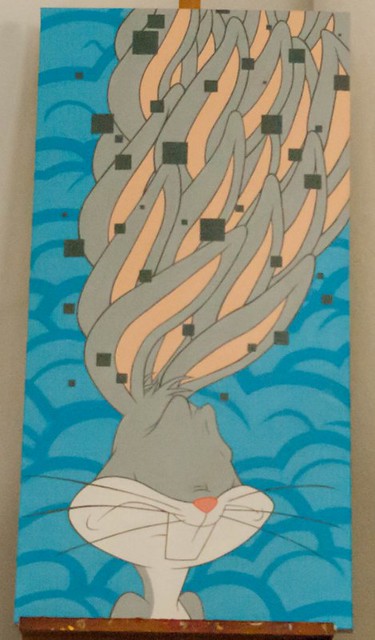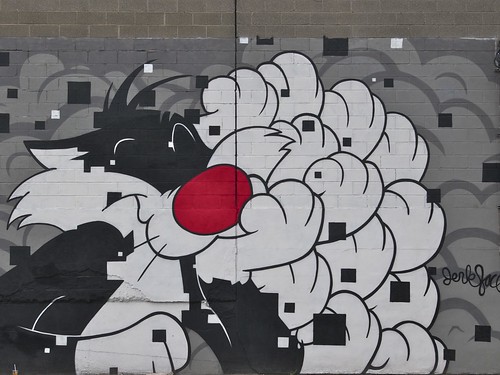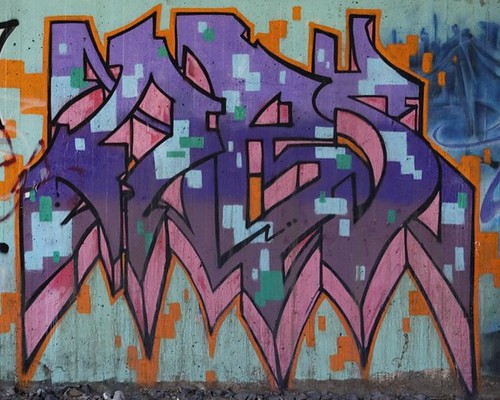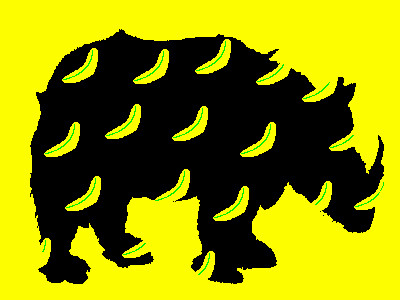Three things are distinctly odd about these images, both by Jerkface – as you see, Bugs Bunny is on canvas; Sylvester is on a wall. Neither face has eyes, and both pictures appear to be “pierced” by a pattern of squares, and Bugs has multiple ears and Sylvester has multiple paws. Note that the pattern of squares doesn’t respect the distinction between foreground and background – well, in the Bugs Bunny it almost does, but it definitely doesn’t in the Sylvester.
Let’s start with the squares. As a comparison, let’s look at this graffiti piece:
In typical fashion the name dominates the image. What interests me are those rectilinear forms walking over the surface. The name-form is bordered in orange and we orange rectilinears merging into that outline, with a few free of it. The blue and green rectilinears within the name-form work a bit differently. Some of them respect the letter-form boundaries, but some extend beneath those boundaries while others go over it.
The overall effect is similar to that of the square’s in the Jerkface images. In all three cases we’ve got to quasi-independent image “logics” that intersect one another in the image plane. One is figural – cartoon characters for Jerkface, a name for the graffiti piece – and the other is a relatively simple geometric pattern.
As I argued in this old post, Graffiti Aesthetics 2: Learning to See, this general phenomenon – intersecting picture logics – is quite common in graffiti. It doesn’t always take this form – rectilinear ‘islands’ floating over the image – but it is often there. The Jerkface images, though, are not, technically speaking, graffit. They’re street art.
But street art and graffiti are closely related expressive forms. For one thing, they’re typically done on outdoor walls – though artists in both worlds also do canvases. And for another, street art is, historically, a child of graffiti. As such, the distinction between the two forms is not a sharp one.
Now, the eyes. What about those missing eyes? Eyes are perhaps the single most important feature in images of the human face. To be sure, Bugs and Sylvester aren’t humans, but they play humans in their cartoons. They talk.
Those missing eyes, consequently, are very striking. We’re more aware of those missing eyes than we would be of the eyes in standard images of Bugs and Sylvester. We expect those eyes to be there and thus think nothing of them when the ARE there. But when they’re missing, we’re VERY AWARE INDEED of that absence.
Now, is there a relationship between those missing eyes and those obtrusive rectangles? Do those rectangles somehow balance out or compensate for those missing eyes? Perhaps, perhaps not. But I don’t think that the existence of those two phenomena in the same image is an accidental. They’re their for a reason, just what that reason is, though, perhaps a bit of a mystery.
I note, however, that the effect is to make you aware of these images AS images without, however, being self-consciously arch about it.
As for the multiple ears and paws, I leave that as an exercise for the reader.
As for the multiple ears and paws, I leave that as an exercise for the reader.
* * * * *
Lo! the Rhinana!




I love the bugs pic. The first stumbling attempt my son made to communicate with me, connecting words with other things when we were teaching him to speak (by contrasting words with parts of the body, Hand, Daddy's hand, Mummy's hand etc), was "monster eyes, Jamie eye's"
ReplyDeleteI was focused on the time on working out what I was going to study in the future, five or six large books on medieval art lying on the bed, all opened with various images of the cynocephali including one of Saint Christopher.
Yep, the eyes are crucial.
Delete